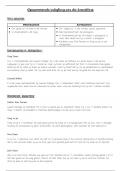MARKETING
COURSE NOTES
UNIVERSITY CARLOS III MADRID – CAMPUS GETAFE
,Marketing
TOPIC 1. INTRODUCTION TO MARKETING
Needs, wants and demand
Evolution of marketing
Production oriented era: Characterized by a focus on production manufacturing processes, exploiting
economies of scale, economies of scope, and experience effects. There is a passive marketing, under the idea
that “product supply creates its own demand.” Product orientation.
Sales oriented era: Characterized by intensive transactional selling tactics, often involving aggressive door-to-
door selling, sales promotions and advertising to persuade customers. More active marketing. The sales
function in marketing becomes central.
Marketing oriented era: Focus on the customer’s latent and existing needs and wants. There is an extensive
use of market research that guide new product development processes. Active marketing. The marketing
research and strategic analysis function in marketing become a key conductor. Customer is central.
What is marketing?
Marketing is first and foremost about satisfying customer needs in a profitable manner. As consumers, you all
know a lot about it!
Marketing 4 Ps
1
,Marketing
Marketing +3 Ps for services
Services management have some peculiarities:
1. Inseparability of production and consumption.
2. Perishability: they cannot be stored.
3. Heterogeneity: difficult to standardize service quality.
4. Intangibility: It is difficult to measure services quality (it can involve multiple features).
5. Quality perception is difficult for consumers, both when forming quality expectations but also ex post.
6. Front-line workers need incentives to perform well.
Consumers satisfaction depends on the gap between perceived quality and expected quality.
Process: flow of activities, policies, procedures, technification, management involvement.
People: Aspect, attitudes, behaviour, and how they affect the contact with customers, participation,
commitment, distinction, incentives, training.
Physical evidence: physical evidences are the elements helping consumers to assess the quality (e.g.,
environment, Furniture, Colour, Layout, Noise Level, auxiliary goods).
Analysis of the environment – Microenvironment
It describes the relationship between firms and the driving forces that control this relationship. The main
factors of the microenvironment are:
Internal factors: Elements within the firm, resources and capabilities generally related to traditional functional
areas (finance, management, production).
Suppliers: individuals and organization that provide the necessary resources to the company to produce goods
(products and services).
Intermediaries/Distributors: individuals and organization helping the company to promote, sell and distribute
its goods to final buyers.
Customers: those individuals and organization buying goods or services to the company.
Competitors (incl. potential): those organizations serving the firm target market with similar products and
services.
General public: Any other social group interested in aspects that interfere in the capacity of the company to
achieve its objectives.
2
, Marketing
Porter’s Five forces Model (PFF)
Analysis of the environment – Macroenvironment
All factors that can influence an organization, but that are out of their direct control. A company does not
generally influence any laws (but they could lobby). It is continuously changing, and the company needs to be
flexible to adapt. There may be aggressive competition and rivalry in a market. Globalization means that there
is always the threat of substitute products and new entrants. The wider environment is also ever changing,
and the marketer needs to compensate for changes in culture, politics, economics, and technology.
PESTLE
3



